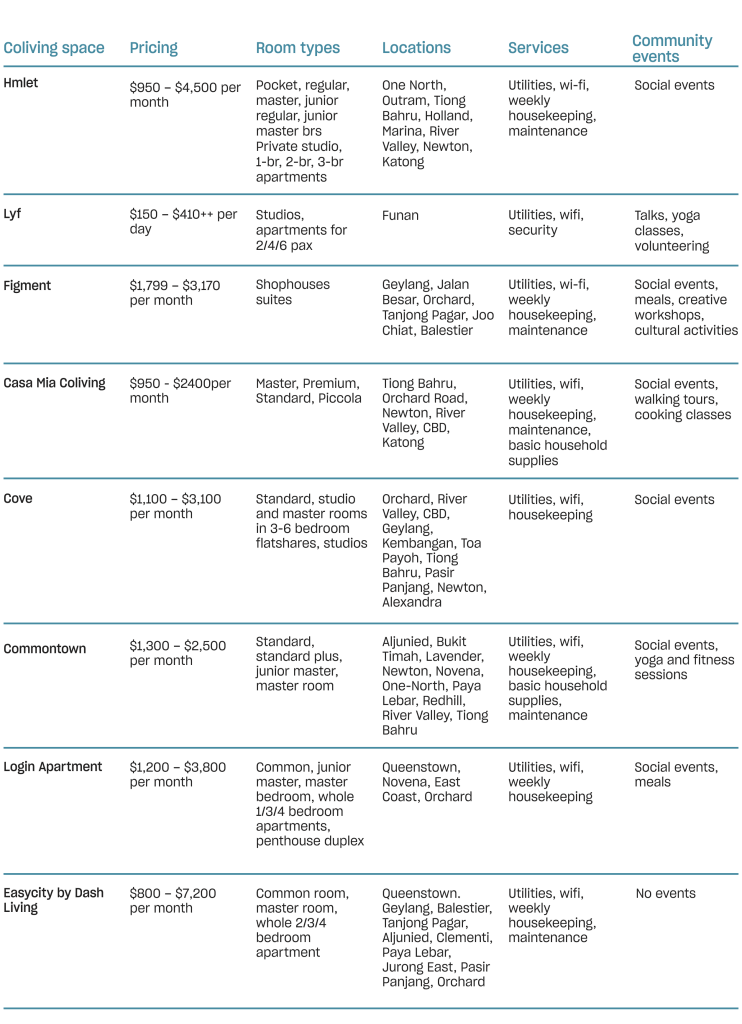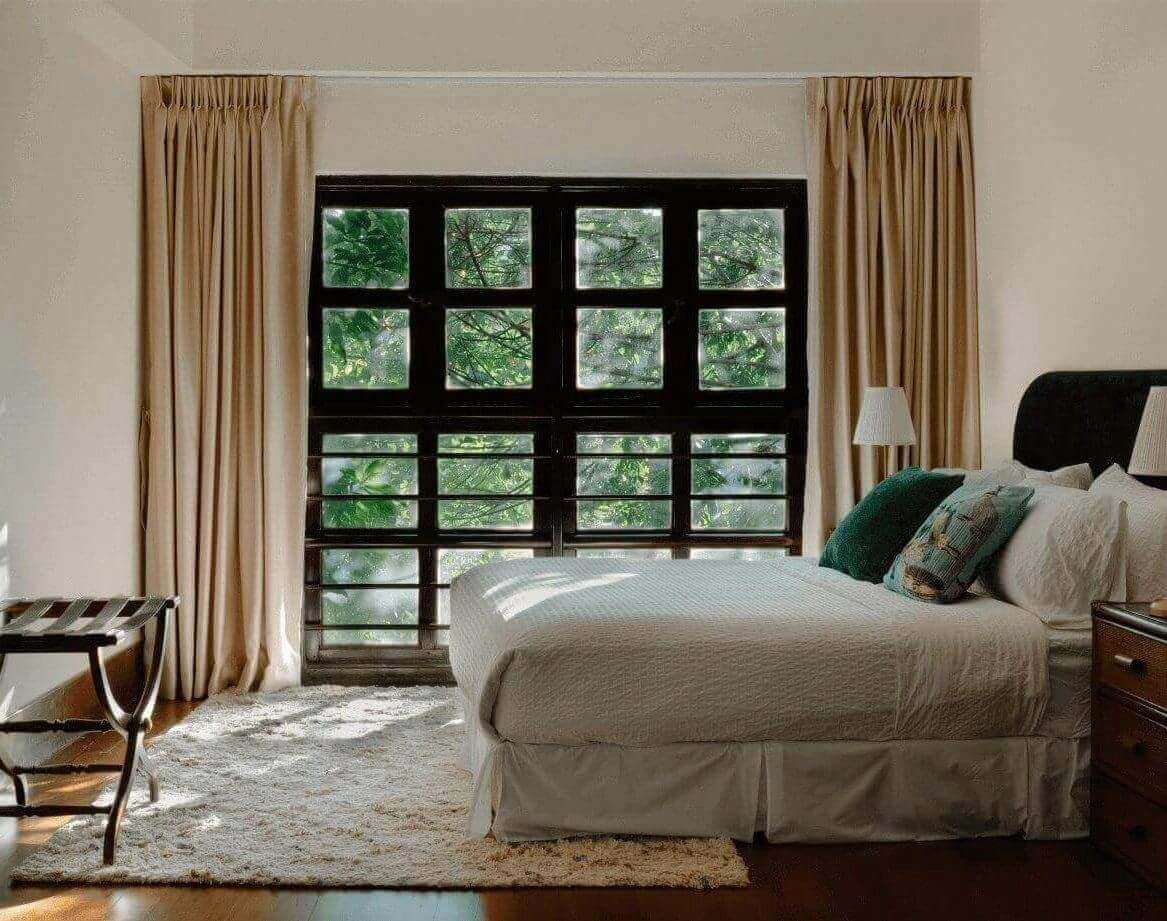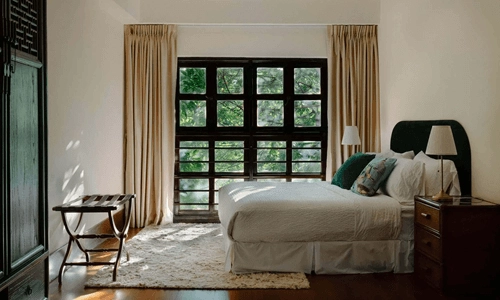A Local’s Guide to
Co-living in Singapore – 2024
5 mins
Imagine stepping out of your bedroom into a community of like-minded people, ensconced in beautiful surroundings. That, in essence, is what co-living tries to achieve. And, judging by the rising popularity of co-living spaces in some of the world’s most vibrant cities, it is succeeding.
Contents
1. What is co-living?
2. Why choose co-living over other forms of accommodation?
3. Best Co-living Spaces in Singapore
4. What is it like living in a co-living space?
5. Is co-living in Singapore worth the money?
6. Post COVID-19 co-living
7. Things to consider before moving in
8. Making the most of your co-living experience
9. Conclusion: Co-living is here to stay
What is co-living?

Co-living is a new form of accommodation enabling residents to live in a community with shared values, while still enjoying the privacy of a self-contained space. Co-living spaces typically consist of bedrooms with en-suite bathrooms, connected by communal spaces such as living rooms and kitchens. However, for the budget-conscious, bedrooms with shared bathrooms are quite common nowadays.
Ready to live different with figment?
Join the 4000+ working professionals Figment has hosted over the past 34 years
Co-living spaces aren’t just places to live. They’re communities with a shared ethos, one of openness, inspiration and freedom. Many co-living providers organise events to encourage members from different properties to mix and mingle.
For this reason, co-living spaces tend to be popular with entrepreneurs, creatives and digital nomads. In practice, co-living spaces are inhabited by a diverse mix of people across a spectrum of ages, from the early twenties to forties and beyond.
And it’s not just singles who’re moving into co-living spaces, either. Some co-living providers provide master bedrooms, suites or entire apartments for couples.
Figment is redefining the co-living experience in conservation shophouses. Learn more about what makes the Figment different.
Why choose co-living over other forms of accommodation?

At first glance, co-living might not seem so different from living in a rental apartment or flatshare. But subtle differences add up to create a markedly distinct experience.
Here are some of the ways co-living is unique.
1) Lots of personal space
Co-living spaces are all about cultivating a sense of community without sacrificing personal space. Instead of compact bedrooms and shared bathrooms, many co-living residents enjoy larger bedrooms with en-suite bathrooms. Some co-living spaces even allocate an entire floor to each resident.
2) Cleaning, maintenance, utilities and wifi are taken care of
The co-living model aims to make things as fuss-free as possible for residents, so logistics such as wifi, utilities and cleaning are taken care of and included in the rent.
3) Shorter contracts
Co-living is a great option for freedom-loving travellers and nomads thanks to short contracts that can range from a few days to a few months. Thereafter, residents are usually given the option to extend their contracts on a month-by-month basis.
4) Authentic living spaces
Co-living spaces are personality-driven and design conscious, and so can offer more interesting living spaces than the prefab residences taking over fast-growing cities. Whether you’d like to live in a historic building or a space that pays homage to local artists, you’re more likely to find inspiration in a co-living space than a typical shareflat.
5) Community and entertainment
Co-living spaces can offer access to a cosmopolitan community, as well as a vast range of entertainment options, from 5G wifi to Smart TVs, to share with your newfound friends.
Best Co-living Spaces in Singapore

Ready to pack your bags and move into a co-living space? Here’s where you can do just that.

Hmlet
Hmlet offers a wide range of modern homes, from shared apartments to entire units. They’ve got over 1,500 properties in most of the areas that are popular with expats and young Singaporeans.
Lyf
Lyf Funan is a blend of a co-living space and a serviced apartment. They only rent out entire units housing one to six people, and are therefore best suited to teams or groups of friends looking for extended time together. Test-drive the concept for as little as one day.
Figment
Figment offers boutique homes in historic shophouses furnished and decorated with the help of local artisans. The properties are located in atmospheric neighbourhoods with well-preserved heritage architecture. All rooms are spacious suites with private bathrooms.
Casa Mia Coliving
Casa Mia offers fully-furnished apartment spaces that are located mostly in the central area of Singapore.
Cove
Cove’s contemporary properties are mostly located in the city core, city fringe and eastern suburbs of Singapore.
Commontown
Commontown operates classic co-living spaces that enable residents to live with roommates in pet-friendly shared apartments.
Login Apartment
With properties in four areas fully furnished in a contemporary style, Login Apartments offers a fuss-free co-living experience with dedicated community managers who organise regular social events for residents across all properties.
Easycity by Dash Living
Easycity offers co-living arrangements as well as corporate housing for business travellers. They have some of the only co-living properties in certain neighbourhoods such as Clementi and Jurong East.
Aggregator Platforms
Instead of trawling through different co-living providers’ sites, aggregators like Coliving.com and Anyplace.com offer a wide selection of co-living arrangements and shareflats from a variety of co-living providers and individual landlords.
Cheapest DIY options
Prefer to find roommates the organic way? Numerous Facebook groups such as Flats & Flatmates in Singapore and Room Rent / Roommate in Singapore are flooded with posts from potential flatmates and landlords looking for tenants.
What is it like living in a co-living space?

Living in shared accommodation comes with its fair share of inconveniences—not having enough personal space, not being allowed to cook by certain landlords, arguments over cleaning and maintenance and cringing at bad décor.
Co-living lets you bypass all of the above by offering a balance between communal living and having your own space, in a beautifully-decorated environment that you’ll enjoy coming home to. AsiaOne calls co-living “the millennials’ or hipsters’ equivalent of home rentals” thanks to the trendy amenities, Insta-worthy interiors and seamless moving-in process.
The community aspect of co-living is strong. After all, residents often pay a slight premium for the chance to be matched with like-minded individuals and gain access to community events.
The convenience factor is another plus, especially for expats who have just landed in Singapore. Co-living spaces enable you to browse available properties on the fly and move in and out on relatively short notice. And of course, the fact that all cleaning, maintenance and bills are taken care of by the co-living company reduces common points of tension between flatmates.
Is co-living in Singapore worth the money?

Co-living is not the absolute cheapest form of rental housing available in Singapore. But it turns out that living in a co-living space is actually not much more expensive than renting similar private properties in city fringe areas.
Utilities, wifi and cleaning are typically included in the rent, and unlike traditional shareflat rentals which require tenants to commit to a one- or two-year lease, co-living tenants are usually free to extend their leases on a month-by-month basis after the first three months.
Ready to live different with figment?
Join the 4000+ working professionals Figment has hosted over the past 34 years
This added value makes co-living a worthwhile expense for those who value the flexibility, convenience and social perks, such as expats or younger free spirits.
Co-living might, however, not be suited to those looking for the most inexpensive housing options available, or those who need a large degree of privacy and space, such as families with kids.
Post COVID-19 co-living

Many co-living operators are taking precautions in order to limit physical contact in light of the COVID-19 pandemic.
For instance, some operators are conducting virtual tours wherever possible and limiting contact with customers at physical viewings.
Co-living spaces offering professional cleaning services are also required to follow the Ministry of Health’s regulations, which include using masks and gloves.
The majority of people entering Singapore from overseas are required to get tested for COVID-19 and serve a 14-day stay at home period. Housemates are required to isolate themselves, take their temperature twice a day, limit contact with other residents and not have visitors over until their stay home notice period is over. In this regard, co-living spaces in which all residents have their own en suite bathrooms are better equipped to cope than traditional shareflats with shared bathrooms.
Things to consider before moving in

Booking a viewing is absolutely free, so do not hesitate to browse properties online and indicate your interest if you find somewhere you’d like to live. No payment or commitment is required to view a residence. If you are unable or prefer not to attend a live visit, many co-living providers now conduct virtual viewings.
When you find a place you like and sign a contract with a co-living provider, you will be asked to pay a deposit (one month’s rent is typical), which will be returned to you when you move out minus any deductions.
The minimum rental period in Singapore is 3 months, but some co-living providers might be able to accommodate shorter stays if you enquire.
Be sure to read through your contract carefully and take note of payment terms, including when you need to pay your rent and how to do so. Also familiarise yourself with the termination terms, taking note of the notice period (30 days is the norm) and how to inform the company when you wish to terminate the contract.
The co-living provider will need a valid ID and, if you are not a Singapore citizen or Permanent Resident, your visa or employment pass.
Making the most of your co-living experience
Co-living can change your life if you let it. The key to making the most out of your stay is to embrace opportunities to connect with the community, while being respectful of others’ (and your own) personal space. Here are some tips for a rewarding co-living experience
– Check out the amenities available at your new home and in the neighbourhood. If your accommodation is in a condo, you’ll probably have a swimming pool and gym at your disposal. Familiarising yourself with your property’s cooking and laundry facilities will help you settle in more quickly. You’ll also want to scout out good shopping and dining options in the vicinity so you know where to hang out.
– Familiarising yourself with the house rules is essential to an agreeable stay for everyone on the property. When are the quiet hours during which to avoid loud noises or doing the laundry? What are the expectations regarding hygiene and cleaning? Following the rules is a form of respect for fellow residents.
– Communication is key! Make time to get to know your housemates at a pace which feels comfortable. Whether you stop for quick chats in the living room or organise frequent weekend get-togethers with the whole crew, take an interest in your fellow residents and you might find yourself with life-long friends.
– While you might understandably be eager to throw yourself into your new-found community, don’t forget to give yourself the alone-time you need. You are not obliged to spend every waking moment interacting with your housemates. Find the right balance you need to feel recharged and energised so you can fully enjoy those moments of social interaction.
– Think about what you want out of your co-living stay so you can empower yourself to achieve your heart’s desire. If you wish to make connections with the other residents, you can send signals that you are open to conversation by working in communal areas rather than in your room and participating actively in community events.
Conclusion: Co-living is here to stay

Co-living offers a unique blend of sociability and privacy in an aesthetically-pleasing space. The flexibility of co-living contracts and the convenience of having all logistics handled in advance make them an excellent choice for the cosmopolitan, the creative and the carefree.
Figment is redefining the co-living experience in conservation shophouses. Learn more about what makes the Figment different.







Comments